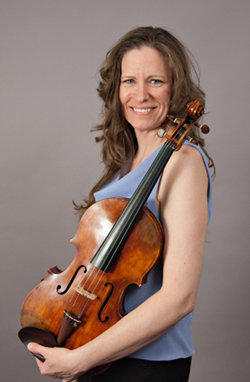Musician’s Statement
 I am thrilled to be featured in this edition of String Poet. I feel that music is poetry, and that my job as a performer is to express the ideas, feelings, and characters created by the composer. Sometimes I have dreams where I am speaking in music; it is my hope that my performances seem that way to those who listen.
I am thrilled to be featured in this edition of String Poet. I feel that music is poetry, and that my job as a performer is to express the ideas, feelings, and characters created by the composer. Sometimes I have dreams where I am speaking in music; it is my hope that my performances seem that way to those who listen.
This CD, “Sprezzatura”, presents two world premieres – the Sonata for Viola and Piano by Paul Chihara, and “Etwas fuer Bratsche, Etwas Rasch” by Paul Siskind. Paul Chihara’s piece was written for his violist wife when he was very ill. Cullan and I heard many different characters in this piece, from sad and resigned to nostalgic to loving. It was inspiring to play a piece that was crafted as a love poem at a time of great suffering, by a man whose last thought was of his feelings for his wife. Although he recovered, the piece survives as a record of his feelings at an extraordinary time.
Paul Siskind’s piece was the result of a request. I asked him to write a piece that was not another elegy, as we violists seem to have a surfeit of them. Hence the “Rasch” in the title. Though, in the end, that word had a double meaning, as the piece was not finished until two weeks before the first performance, making our preparations also “etwas Rasch”. The piece is a virtuosic romp that can tell many different stories, based on the feelings of the listener. I invite you to explore it in whatever way suits your mood.
The Hindemith sonata on our CD is probably the least-recorded of this great violist’s sonatas for his own instrument, largely because of the difficulty of the piano part. It was a joy to work with such a talented and sensitive pianist on this masterpiece. We were determined to show that Hindemith’s music is not harsh, but rather the opposite – delicate, rhythmically complex, and very reminiscent of Classical composers like Mozart and Beethoven, although with a different sound palette. The greatest compliment we received was from the reviewer at The Strad, who said that we played Hindemith like Mozart. This music is, for me, all about rhythm. It makes my body move on the inside when I hear it or play it, much the way that Shakespeare affects me when I read. There is movement here, and color, and character to spare. We loved this piece more every single time that we played it.
Britten’s Lachrymae is based on two Dowland songs from the Renaissance, both of which are very sad. Like the great poets, Britten confronts the ultimate mystery of death in an attempt to make sense of its loss and pain. I think of it as a “Variations and Theme”, as the most complete statement of either one of the songs happens at the end. I first performed this piece shortly after my father’s death, and my thoughts about it at the time have stayed with me. I hear it as a set of variations exploring grief in all of its facets – denial, fond memories, anger, confusion, and finally, in the end, acceptance. The colors we created at the end seek to evoke the Renaissance sound of a viola da gamba, in a transparent moment of love and the realization that death is not the end.